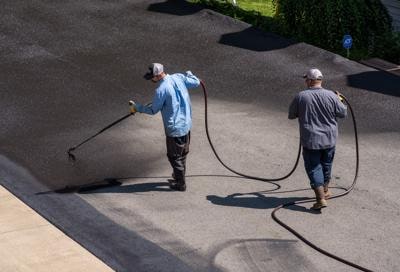Hot Mix Asphalt: A Lasting Option for Pavement
Hot Mix Asphalt (HMA) has become a leading sustainable choice for sidewalk solutions, providing a myriad of ecological benefits and ingenious technologies. Its ability to decrease and recycle materials energy consumption presents a compelling instance for its fostering in roadway building jobs. The long-lasting performance and durability of HMA make it a recommended choice for facilities development. As the need for green building practices expands, checking out the nuances of HMA's sustainability can give useful insights right into the future of pavement solutions.
Environmental Benefits of Warm Mix Asphalt

In Addition, Hot Mix Asphalt aids to reduce urban warm island results. Its dark shade soaks up sunlight, decreasing the quantity of heat showed back right into the atmosphere contrasted to lighter-colored pavements. This can reduce ambient temperature levels in urban locations, decreasing the demand for a/c and ultimately decreasing power intake.
Furthermore, Hot Mix Asphalt adds to boosted stormwater administration. Its porous nature permits water to reenergize and infiltrate the sidewalk groundwater products, minimizing runoff and the danger of flooding. These ecological benefits make Hot Mix Asphalt a sustainable option for leading roadways and freeways.
Energy Performance in HMA Production
Is power effectiveness an important aspect in the production of Warm Mix Asphalt (HMA)? Power plays a significant duty in the manufacturing of HMA, impacting both price and ecological sustainability. One essential facet of power efficiency in HMA manufacturing is the use of cozy mix asphalt (WMA) innovations.
Additionally, innovations in plant technologies have actually led to even more energy-efficient HMA manufacturing processes. By maximizing power usage in HMA manufacturing, the sector can reduce its carbon impact while preserving premium sidewalk products.
Recyclability of Warm Mix Asphalt
The recyclability of Warm Mix Asphalt (HMA) is an essential facet of its sustainability and long-term ecological impact. HMA is among one of the most recycled products in the USA, with over 100 million lots of redeemed asphalt sidewalk (RAP) being recycled annually in new pavement building. Reusing HMA supplies numerous environmental benefits, such as decreasing the requirement for virgin products, decreasing power intake throughout manufacturing, and lowering the quantity of waste sent out to land fills.
The procedure of reusing HMA involves crushing the existing sidewalk, crushing it right into smaller sized pieces, and mixing it with brand-new aggregate and asphalt binder to develop a recycled mix. In general, the recyclability of HMA plays a considerable role in advertising sustainable methods within the pavement industry.

Long-Term Performance of HMA
Asphalt pavements demonstrate toughness and resilience over a prolonged duration, showing the long-lasting efficiency of Warm Mix Asphalt (HMA) The durability of HMA can be credited to its capability to stand up to hefty website traffic lots, you could look here extreme weather, and the impacts of aging. Research studies have shown that well-designed and properly find more created HMA sidewalks can last for two decades or even more with routine maintenance. The key to optimizing the long-lasting performance of HMA lies in making use of high-grade products, complying with best practices in building and construction, and applying efficient maintenance strategies. Correct drain, routine inspections, and prompt repair services are vital for preserving the architectural stability of HMA pavements with time. Furthermore, developments in HMA technology, such as the usage of polymer-modified binders and cozy mix asphalt, have even more improved the sturdiness and longevity of HMA sidewalks. By prioritizing top quality building and upkeep methods, HMA remains to confirm itself as a economical and sustainable option for resilient pavement infrastructure.

HMA: Sturdiness and Sustainability
Demonstrating both longevity and sustainability, Warm Mix Asphalt (HMA) has ended up being a cornerstone in the building and construction of resilient pavement facilities - angled parking. HMA's longevity comes from its ability to stand up to heavy tons, harsh weather, and high web traffic volumes, making it a trusted option for roadways, freeways, and airport paths. The composition of HMA, which commonly includes accumulations, binder, and filler, plays a vital role in boosting its durability and resistance to tear and use
Moreover, HMA's sustainability lies in its recyclability and energy-efficient manufacturing process. The capability to reuse recovered asphalt sidewalk (RAP) in brand-new HMA mixes minimizes the need for virgin products and minimizes the ecological influence of sidewalk building and construction and upkeep. Additionally, the energy effectiveness of generating HMA hinges on its lower mixing temperatures contrasted to other pavement products, leading to minimized power intake and greenhouse gas exhausts.
Conclusion
In final thought, hot mix asphalt (HMA) offers a lasting remedy for sidewalk with its environmentally friendly qualities. HMA's recyclability, energy efficiency in manufacturing, and long-lasting toughness make it a green option for road building and construction.
HMA is one of the most recycled materials in the United States, with over 100 million loads of reclaimed asphalt sidewalk (RAP) being reused each year in brand-new pavement building and construction.The process of recycling HMA entails milling the existing sidewalk, crushing it right into smaller items, and blending it with new accumulation and asphalt binder to produce a recycled mix.Asphalt sidewalks show toughness and durability over an extended duration, reflecting the long-term efficiency of Hot Mix Asphalt (HMA) Furthermore, advancements in HMA modern technology, such as the use of polymer-modified binders and cozy mix asphalt, have actually further boosted the durability and longevity of HMA sidewalks. The capability to recycle reclaimed asphalt sidewalk (RAP) in new HMA blends reduces the demand for virgin products and reduces the ecological influence great post to read of pavement building and construction and maintenance.